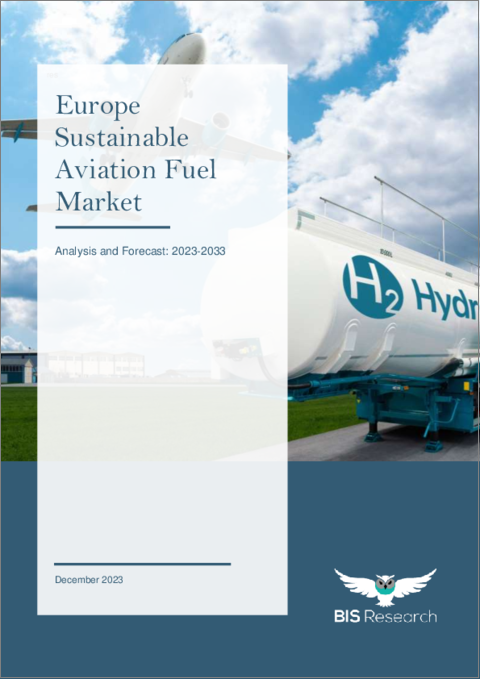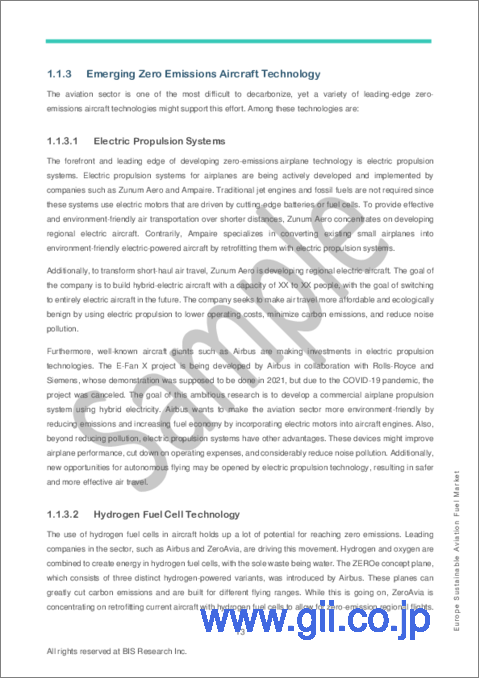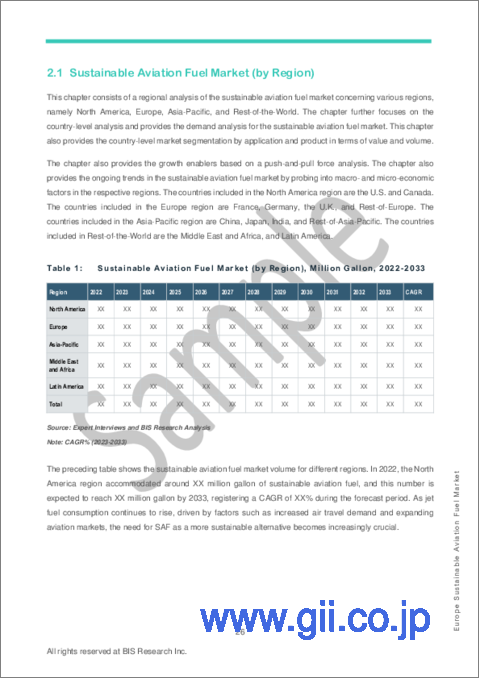|
|
市場調査レポート
商品コード
1393901
欧州の持続可能航空燃料市場の分析・予測:2023-2033年Europe Sustainable Aviation Fuel Market - Analysis and Forecast, 2023-2033 |
||||||
カスタマイズ可能
|
|||||||
| 欧州の持続可能航空燃料市場の分析・予測:2023-2033年 |
|
出版日: 2023年12月08日
発行: BIS Research
ページ情報: 英文 103 Pages
納期: 1~5営業日
|
- 全表示
- 概要
- 図表
- 目次
欧州の持続可能航空燃料の市場規模は、2022年の9,690万米ドルから、予測期間中は58.03%のCAGRで推移し、2033年には182億3,890万米ドルの規模に成長すると予測されています。
温室効果ガスの排出量を削減し、航空業が気候変動に与える影響を軽減することが急務となっていることから、持続可能航空燃料 (SAF) は航空業界において重要な分野となっており、急速に拡大しています。政府、航空会社、その他の業界関係者は、持続可能性目標の達成に取り組む中で、SAF市場に一層の注力と資本投入を行っています。
持続可能航空燃料 (SAF) に対する世界の関心と利用は、現在劇的に高まっています。気候変動や航空業界による環境への悪影響に対する懸念の拡大により、従来のジェット燃料に代わるよりクリーンな燃料が切実に求められています。そのため、バイオマス、食用油残渣、水素などの持続可能原料から作られるSAFは、実用的なソリューションを提供してきました。最新の技術とコラボレーションは、SAFの製造能力を向上させ、サプライチェーンを合理化し、事業のコストダウンを実現することで、業界を推進しています。
当レポートでは、欧州の持続可能航空燃料の市場を調査し、市場概要、技術動向、市場成長への各種影響因子の分析、市場規模の推移・予測、各種区分・主要国別の詳細分析、競合情勢、主要企業の分析などをまとめています。
| 主要市場統計 | |
|---|---|
| 予測期間 | 2023-2033年 |
| 2023年評価 | 1億8,700万米ドル |
| 2033年予測 | 182億3,000万米ドル |
| CAGR | 58.03% |
市場の分類
セグメンテーション1:用途別
- 民間航空
- ビジネス・一般航空
- 軍用航空
- 無人航空機 (UAV)
セグメンテーション2:燃料タイプ別
- 水素燃料
- バイオ燃料
- 液体燃料
- 液化ガス燃料
セグメンテーション3:製造技術別
- フィッシャートロプシュ合成パラフィン灯油 (FT-SPK)
- 水素化エステル脂肪酸合成パラフィン灯油 (HEFA-SPK)
- アルコールジェット合成パラフィン灯油 (ATJ-SPK)
- 発酵水添糖からの合成ISOパラフィン (HFS-SIP)
- 触媒的加水分解ジェット (CHJ)
セグメンテーション4:国別
- 英国
- ドイツ
- フランス
- その他
目次
第1章 市場
- 業界の展望
- 持続可能航空燃料市場:概要
- 航空業界における排出ガス規制対策の進化
- 新たなゼロエミッション航空機技術
- 現在および将来の技術動向
- 進化する航空推進技術:排出量削減に向けた移行
- 持続可能航空燃料採用のための重要な成功パラメータ
- 事業力学
- 事業促進要因
- 事業上の課題
- 事業機会
- 事業戦略
第2章 地域
- 持続可能航空燃料市場 (地域別)
- 欧州
- 市場
- 用途
- 製品
- 欧州 (国別)
第3章 市場:競合ベンチマーキング・企業プロファイル
- 競合ベンチマーキング
- 企業プロファイル
- BP p.l.c.
- Shell
- Neste
- SkyNRG
- Velocys plc
- TotalEnergies
第4章 調査手法
List of Figures
- Figure 1: Sustainable Aviation Fuel Market, $Billion, 2022-2033
- Figure 2: Sustainable Aviation Fuel Market, Million Gallon, 2022-2033
- Figure 3: Sustainable Aviation Fuel Market (by Application), $Billion, 2022 and 2033
- Figure 4: Sustainable Aviation Fuel Market (by Fuel Type), $Billion, 2022 and 2033
- Figure 5: Sustainable Aviation Fuel Market (by Manufacturing Technology), $Billion, 2022 and 2033
- Figure 6: Sustainable Aviation Fuel Market (by Region), $Billion, 2033
- Figure 7: Sustainable Aviation Fuel Market, Business Dynamics
- Figure 8: Jet Fuel Prices, May 2018-March 2023
- Figure 9: Share of Key Business Strategies and Developments, January 2020-June 2023
- Figure 10: Sustainable Aviation Fuel Market, Competitive Benchmarking
- Figure 11: Research Methodology
- Figure 12: Top-Down and Bottom-Up Approach
- Figure 13: Assumptions and Limitations
List of Tables
- Table 1: Market Developments, January 2020-June 2023
- Table 2: Partnerships, Collaborations, Agreements, and Contracts, January 2020-June 2023
- Table 3: Sustainable Aviation Fuel Market (by Region), Million Gallon, 2022-2033
- Table 4: Sustainable Aviation Fuel Market (by Region), $Million, 2022-2033
- Table 5: Europe Sustainable Aviation Fuel Market (by Application), $Million, 2022-2033
- Table 6: Europe Sustainable Aviation Fuel Market (by Fuel Type), Million Gallon, 2022-2033
- Table 7: Europe Sustainable Aviation Fuel Market (by Fuel Type), $Million, 2022-2033
- Table 8: Europe Sustainable Aviation Fuel Market (by Manufacturing Technology), $Million, 2022-2033
- Table 9: France Sustainable Aviation Fuel Market (by Application), $Million, 2022-2033
- Table 10: France Sustainable Aviation Fuel Market (by Fuel Type), Million Gallon, 2022-2033
- Table 11: France Sustainable Aviation Fuel Market (by Fuel Type), $Million, 2022-2033
- Table 12: Germany Sustainable Aviation Fuel Market (by Application), $Million, 2022-2033
- Table 13: Germany Sustainable Aviation Fuel Market (by Fuel Type), Million Gallon, 2022-2033
- Table 14: Germany Sustainable Aviation Fuel Market (by Fuel Type), $Million, 2022-2033
- Table 15: U.K. Sustainable Aviation Fuel Market (by Application), $Million, 2022-2033
- Table 16: U.K. Sustainable Aviation Fuel Market (by Fuel Type), Million Gallon, 2022-2033
- Table 17: U.K. Sustainable Aviation Fuel Market (by Fuel Type), $Million, 2022-2033
- Table 18: Rest-of-Europe Sustainable Aviation Fuel Market (by Application), $Million, 2022-2033
- Table 19: Rest-of-Europe Sustainable Aviation Fuel Market (by Fuel Type), Million Gallon, 2022-2033
- Table 20: Rest-of-Europe Sustainable Aviation Fuel Market (by Fuel Type), $Million, 2022-2033
- Table 21: BP p.l.c.: Product Portfolio
- Table 22: BP p.l.c.: Partnerships, Collaborations, Agreements, and Contracts
- Table 23: Shell: Product Portfolio
- Table 24: Shell: Partnerships, Collaborations, Agreements, Investments, and Contracts
- Table 25: Shell: Market Developments
- Table 26: Neste: Product Portfolio
- Table 27: Neste: Partnerships, Collaborations, Agreements, Investments, and Contracts
- Table 28: Neste: Market Developments
- Table 29: SkyNRG: Product Portfolio
- Table 30: SkyNRG: Market Developments
- Table 31: SkyNRG: Partnerships, Collaborations, Agreements, and Contracts
- Table 32: Velocys plc: Product Portfolio
- Table 33: Velocys plc: Partnerships, Collaborations, Agreements, and Contracts
- Table 34: Velocys plc: Market Developments
- Table 35: TotalEnergies: Product Portfolio
- Table 36: TotalEnergies: Partnerships, Collaborations, Agreements, and Contracts
- Table 37: TotalEnergies: Market Developments
“The Europe Sustainable Aviation Fuel Market Expected to Reach $18.23 Billion by 2033.”
Introduction to Europe Sustainable Aviation Fuel Market
The Europe sustainable aviation fuel market was valued at $96.9 million in 2022 and is anticipated to reach $18,238.9 million by 2033, witnessing a CAGR of 58.03% during the forecast period 2023-2033. Due to the pressing need to lower greenhouse gas emissions and lessen the impact of aviation on climate change, the market for sustainable aviation fuel (SAF) has become an important and quickly expanding segment within the aviation industry. SAF, commonly referred to as biojet fuel, is produced using renewable energy sources, algae, and agricultural waste as sustainable feedstocks. It provides a competitive substitute for traditional jet fuel by cutting emissions of carbon dioxide and other pollutants to a great extent. Governments, airlines, and other industry players are putting more focus and capital into the SAF market as they work to meet their sustainability targets. The market for sustainable aviation fuel has enormous potential for innovation, teamwork, and good environmental impact. It has the ability to transform aviation and contribute to a more environmentally friendly future.
| KEY MARKET STATISTICS | |
|---|---|
| Forecast Period | 2023 - 2033 |
| 2023 Evaluation | $.187 Billion |
| 2033 Forecast | $18.23 Billion |
| CAGR | 58.03% |
Market Introduction
The concept of sustainable aviation fuel, or SAF, has a lengthy history that began in the early 2000s as environmental and climate change awareness began to grow. Scholars and business experts agreed that the need for alternative fuels was necessary in order to reduce greenhouse gas emissions and reliance on fossil fuels. Initially, the emphasis was on biofuels derived from plants like soybeans and sugarcane. In 2008, the first commercial aircraft using a blend of normal jet fuel and biofuel was launched. Since then, there have been significant advancements in the development and adoption of SAF, including upgrades to the certification standards, the refining processes, and the range of feedstocks utilized.
Worldwide interest in and use of sustainable aviation fuel, or SAF, is now rising dramatically. Concerns over climate change and the aviation industry's detrimental environmental effects are growing, making cleaner alternatives to traditional jet fuels desperately needed. Thus, SAF, which is made from sustainable feedstocks like biomass, leftover cooking oil, or hydrogen, has offered a practical solution. Modern technology and collaborations are propelling the industry forward by increasing SAF manufacturing capacity, streamlining the supply chain, and bringing down costs for businesses. The resolution of difficulties pertaining to scalability, feedstock availability, and regulatory frameworks is imperative in order to promote the adoption of SAF and provide a more sustainable future for aviation.
Market Segmentation:
Segmentation 1: by Application
- Commercial Aviation
- Business and General Aviation
- Military Aviation
- Unmanned Aerial Vehicle (UAV)
Segmentation 2: by Fuel Type
- Hydrogen Fuel
- Biofuel
- Power-to-Liquid Fuel
- Gas-to-Liquid Fuel
Segmentation 3: by Manufacturing Technology
- Fischer-Tropsch Synthetic Paraffinic Kerosene (FT-SPK)
- Hydroprocessed Esters and Fatty Acids-Synthetic Paraffinic Kerosene (HEFA-SPK)
- Alcohol-to-Jet Synthetic Paraffinic Kerosene (ATJ-SPK)
- Synthetic ISO-Paraffin from Fermented Hydroprocessed Sugar (HFS-SIP)
- Catalytic Hydrothermolysis Jet (CHJ)
Segmentation 4: by Country
- U.K.
- Germany
- France
- Rest-of-Europe
How can this report add value to an organization?
Product/Innovation Strategy: The product segment helps the reader understand the different types of products available for deployment and their potential in europe region. Moreover, the study provides the reader with a detailed understanding of the sustainable aviation fuel market by application (commercial aviation, business and general aviation, military aviation and unmanned aerial vehicle (UAV), product on the basis of fuel type (hydrogen fuel, biofuel, power-to-liquid fuel, and gas-to-liquid fuel), and manufacturing technology (fischer-tropsch synthetic paraffinic kerosene (FT-SPK), hydroprocessed esters and fatty acids-synthetic paraffinic kerosene (HEFA-SPK), alcohol-to-jet synthetic paraffinic kerosene (ATJ-SPK), synthetic ISO-paraffin from fermented hydroprocessed sugar (HFS-SIP).
Growth/Marketing Strategy: The sustainable aviation fuel market has seen major development by key players operating in the market, such as business expansion, partnership, collaboration, and joint venture. The favored strategy for the companies has been merger and acquisition to strengthen their position in the sustainable aviation fuel market. For instance, in February 2023, Fulcrum BioEnergy stated that its U.K. subsidiary, Fulcrum BioEnergy, Ltd., has been awarded a grant from the U.K. Department for Transport Advanced Fuels Fund of over $20.2 million. The award, which is valid through 2025, will aid in the construction of Fulcrum NorthPoint, a plant that will convert residual waste into sustainable aviation fuel (SAF) at the Essar Stanlow site.
Competitive Strategy: Key players in the sustainable aviation fuel market analyzed and profiled in the study involve major sustainable aviation fuel offering companies providing sustainable aviation fuel and different manufacturing technology. Moreover, a detailed competitive benchmarking of the players operating in the sustainable aviation fuel market has been done to help the reader understand how players stack against each other, presenting a clear market landscape. Additionally, comprehensive competitive strategies such as partnerships, agreements, and collaborations will aid the reader in understanding the untapped revenue pockets in the market.
Methodology: The research methodology design adopted for this specific study includes a mix of data collected from primary and secondary data sources. Both primary resources (key players, market leaders, and in-house experts) and secondary research (a host of paid and unpaid databases), along with analytical tools, are employed to build the predictive and forecast models.
Key Market Players and Competition Synopsis
The companies that are profiled have been selected based on thorough secondary research, which includes analyzing company coverage, product portfolio, market penetration, and insights, which are gathered from primary experts.
The key players operating and present in the Europe sustainable aviation fuel market include:
|
|
Table of Contents
1 Markets
- 1.1 Industry Outlook
- 1.1.1 Sustainable Aviation Fuel Market: Overview
- 1.1.2 Evolving Emission Control Measures in the Aviation Industry
- 1.1.3 Emerging Zero Emissions Aircraft Technology
- 1.1.3.1 Electric Propulsion Systems
- 1.1.3.2 Hydrogen Fuel Cell Technology
- 1.1.3.3 Advanced Aerodynamics and Lightweight Materials
- 1.1.3.4 Urban Air Mobility (UAM) and Electric Vertical Take-Off and Landing (eVTOL)
- 1.1.4 Current and Future Technological Trends
- 1.1.4.1 Carbon Capture and Utilization (CCU) Technologies
- 1.1.4.2 Direct Air Capture (DAC) Technologies
- 1.1.5 Evolving Aviation Propulsion Technologies: Migration Toward Reduced Emissions
- 1.1.6 Critical Success Parameters for Sustainable Aviation Fuel Adoption
- 1.2 Business Dynamics
- 1.2.1 Business Drivers
- 1.2.1.1 Increasing Environmental Concerns
- 1.2.1.2 Volatile Jet Fuel Prices
- 1.2.1.3 Advances in Conversion Technologies
- 1.2.2 Business Challenges
- 1.2.2.1 Infrastructure Development Cost
- 1.2.2.2 Certification and Sustainability Criteria
- 1.2.2.3 Inadequate Supply of Feedstock
- 1.2.3 Business Opportunities
- 1.2.3.1 SAF Offtake Agreements
- 1.2.4 Business Strategies
- 1.2.4.1 Market Developments
- 1.2.4.2 Partnerships, Collaborations, Agreements, and Contracts
- 1.2.1 Business Drivers
2 Region
- 2.1 Sustainable Aviation Fuel Market (by Region)
- 2.2 Europe
- 2.2.1 Market
- 2.2.1.1 Key Players in Europe
- 2.2.1.2 Business Drivers
- 2.2.1.3 Business Challenges
- 2.2.2 Application
- 2.2.2.1 Europe Sustainable Aviation Fuel Market (by Application)
- 2.2.3 Product
- 2.2.3.1 Europe Sustainable Aviation Fuel Market (by Fuel Type)
- 2.2.3.2 Europe Sustainable Aviation Fuel Market (by Manufacturing Technology)
- 2.2.4 Europe (by Country)
- 2.2.4.1 France
- 2.2.4.1.1 Market
- 2.2.4.1.1.1 Key Players in France
- 2.2.4.1.2 Application
- 2.2.4.1.2.1 France Sustainable Aviation Fuel Market (by Application)
- 2.2.4.1.3 Product
- 2.2.4.1.3.1 France Sustainable Aviation Fuel Market (by Fuel Type)
- 2.2.4.1.1 Market
- 2.2.4.2 Germany
- 2.2.4.2.1 Market
- 2.2.4.2.1.1 Key Players in Germany
- 2.2.4.2.2 Application
- 2.2.4.2.2.1 Germany Sustainable Aviation Fuel Market (by Application)
- 2.2.4.2.3 Product
- 2.2.4.2.3.1 Germany Sustainable Aviation Fuel Market (by Fuel Type)
- 2.2.4.2.1 Market
- 2.2.4.3 U.K.
- 2.2.4.3.1 Market
- 2.2.4.3.1.1 Key Players in the U.K.
- 2.2.4.3.2 Application
- 2.2.4.3.2.1 U.K. Sustainable Aviation Fuel Market (by Application)
- 2.2.4.3.3 Product
- 2.2.4.3.3.1 U.K. Sustainable Aviation Fuel Market (by Fuel Type)
- 2.2.4.3.1 Market
- 2.2.4.4 Rest-of-Europe
- 2.2.4.4.1 Market
- 2.2.4.4.1.1 Key Players in Rest-of-Europe
- 2.2.4.4.2 Application
- 2.2.4.4.2.1 Rest-of-Europe Sustainable Aviation Fuel Market (by Application)
- 2.2.4.4.3 Product
- 2.2.4.4.3.1 Rest-of-Europe Sustainable Aviation Fuel Market (by Fuel Type)
- 2.2.4.4.1 Market
- 2.2.4.1 France
- 2.2.1 Market
3 Markets - Competitive Benchmarking & Company Profiles
- 3.1 Competitive Benchmarking
- 3.2 Company Profiles
- 3.2.1 BP p.l.c.
- 3.2.1.1 Company Overview
- 3.2.1.1.1 Role of BP p.l.c. in the Sustainable Aviation Fuel Market
- 3.2.1.1.2 Product Portfolio
- 3.2.1.2 Corporate Strategies
- 3.2.1.2.1 Partnerships, Collaborations, Agreements, and Contracts
- 3.2.1.3 Analyst View
- 3.2.1.1 Company Overview
- 3.2.2 Shell
- 3.2.2.1 Company Overview
- 3.2.2.1.1 Role of Shell in the Sustainable Aviation Fuel Market
- 3.2.2.1.2 Product Portfolio
- 3.2.2.2 Corporate Strategies
- 3.2.2.2.1 Partnerships, Collaborations, Agreements, Investments, and Contracts
- 3.2.2.3 Business Strategies
- 3.2.2.3.1 Market Developments
- 3.2.2.4 Analyst View
- 3.2.2.1 Company Overview
- 3.2.3 Neste
- 3.2.3.1 Company Overview
- 3.2.3.1.1 Role of Neste in the Sustainable Aviation Fuel Market
- 3.2.3.1.2 Product Portfolio
- 3.2.3.2 Corporate Strategies
- 3.2.3.2.1 Partnerships, Collaborations, Agreements, Investments, and Contracts
- 3.2.3.3 Business Strategies
- 3.2.3.3.1 Market Developments
- 3.2.3.4 Analyst View
- 3.2.3.1 Company Overview
- 3.2.4 SkyNRG
- 3.2.4.1 Company Overview
- 3.2.4.1.1 Role of SkyNRG in the Sustainable Aviation Fuel Market
- 3.2.4.1.2 Product Portfolio
- 3.2.4.2 Business Strategies
- 3.2.4.2.1 Market Developments
- 3.2.4.3 Corporate Strategies
- 3.2.4.3.1 Partnerships, Collaborations, Agreements, and Contracts
- 3.2.4.4 Analyst View
- 3.2.4.1 Company Overview
- 3.2.5 Velocys plc
- 3.2.5.1 Company Overview
- 3.2.5.1.1 Role of Velocys plc in the Sustainable Aviation Fuel Market
- 3.2.5.1.2 Product Portfolio
- 3.2.5.2 Corporate Strategies
- 3.2.5.2.1 Partnerships, Collaborations, Agreements, and Contracts
- 3.2.5.3 Business Strategies
- 3.2.5.3.1 Market Developments
- 3.2.5.4 Analyst View
- 3.2.5.1 Company Overview
- 3.2.6 TotalEnergies
- 3.2.6.1 Company Overview
- 3.2.6.1.1 Role of TotalEnergies in the Sustainable Aviation Fuel Market
- 3.2.6.1.2 Product Portfolio
- 3.2.6.2 Corporate Strategies
- 3.2.6.2.1 Partnerships, Collaborations, Agreements, and Contracts
- 3.2.6.3 Business Strategies
- 3.2.6.3.1 Market Developments
- 3.2.6.4 Analyst View
- 3.2.6.1 Company Overview
- 3.2.1 BP p.l.c.
4 Research Methodology
- 4.1 Factors for Data Prediction and Modeling





